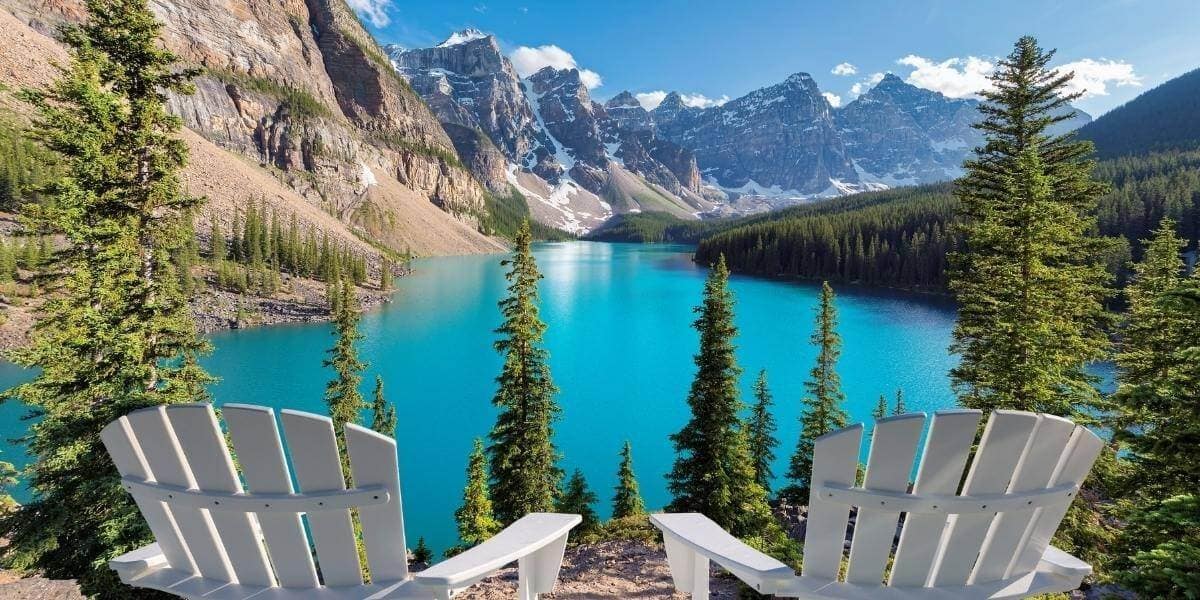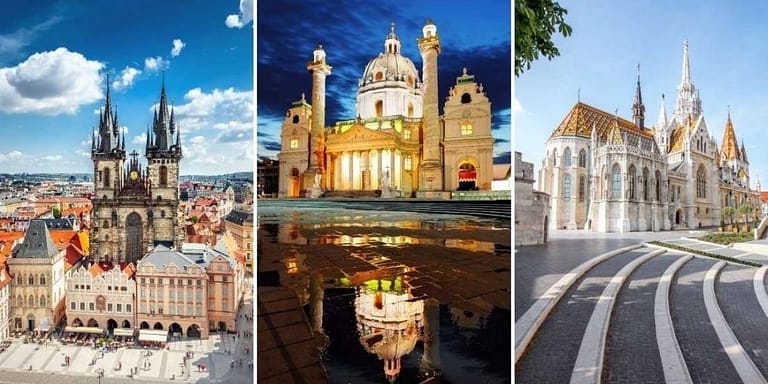20 Remarkable UNESCO World Heritage Sites in Canada
Currently, there are 20 official UNESCO World Heritage Sites in Canada. Nine are in the cultural category, 10 in the natural category, and one is a mixed site. Additionally, there are 11 sites on a tentative list, which means that there could be more UNESCO sites in Canada in the future.
The World Heritage Committee selects UNESCO World Heritage Sites based on a set of criteria. Canada’s UNESCO World Heritage Sites were chosen for their significance to the country’s rich cultural heritage, outstanding landscapes, and human and natural evolution. Each has a remarkable history. Here is what you need to know about them.
Affiliate Disclosure – This post contains affiliate links. If you make a purchase through these links, I may earn a commission. This doesn’t affect your purchases or any fees you may pay for the product or service. Read more in my DISCLAIMER.
Cultural UNESCO World Heritage Sites in Canada
This is probably the most recognizable category when it comes to World Heritage Sites. Many historical buildings, archeological sites, museums, libraries and works of art fall under this category.
They are part of the cultural heritage of a group or society. Think masterpieces of human genius and outstanding examples of architectural or technological advancement. Cultural traditions of long-lost civilizations and human settlement.
While not as widely known as others in the world, here are the nine cultural UNESCO World Heritage Sites in Canada.
Head-Smashed-In Buffalo Jump (1981)
The Head-Smashed-In Buffalo Jump site in southwestern Alberta makes the list for its evidence of pre-historic life. This is the oldest and best-preserved buffalo jump in North America. What exactly is a buffalo jump? Well, it’s exactly what it sounds like.

For almost 6,000 years, the indigenous people living here have hunted wild bison (buffalo) that roamed the area. To make the process efficient, they would drive the animals from the nearby Porcupine Hills and herd them toward the cliff’s edge, where they then fell to their deaths. The animal carcasses would then be processed in a camp below, using all the animal parts for food, clothing and tools. There is evidence of sophisticated operations and about 11 metres (36 feet) of animal bones.
The practice came to an end in the 19th century, and the site was added to the UNESCO World Heritage Site in Canada list in 1981.
Historic District of Old Québec (1985)
With over 400 years of history, the Historic District of Quebec City is a unique spot in Canada. Founded by the French in the 17th century, Quebec City is one of the oldest towns in North America. It is also the only fortified (and preserved) city north of Mexico.


Quebec City has an old European town vibe with narrow cobblestone streets, centuries-old stone houses, and soaring church spires. It’s a testament to French culture, architecture and history. It’s not a surprise that it made the list of World Heritage Sites in Canada in 1985.
L’Anse aux Meadows National Historic Site (1978)
While the Genoese explorer Christopher Columbus is widely accredited with discovering the New World, he wasn’t the first to reach North America. The Viking explorer Leif Erikson ventured across the ocean until he reached what eventually became Canada a few centuries before Columbus.

The L’Anse aux Meadows National Site is an 11th-century Nordic settlement on the Great Northern Peninsula in Newfoundland. These Viking ruins are the earliest European settlement on the continent, with the peat-turf building design resembling those found in Iceland and Greenland.
The site makes the list of UNESCO World Heritage Sites in Canada as a significant achievement of human migration.
The Landscape of Grand Pré (2012)
Located in the Minas Basin of Nova Scotia, the Landscape of Grand Pré’s significance comes from its location. As an inlet of the Bay of Fundy, this area experiences some of the most extreme tides in the world, often averaging 11.6 metres (38 feet).
During the early 17th century, French settlers (Acadians) braved this harsh, unknown landscape to create fertile farmland long before engineered drainage systems. Their transformation of this land stands as a testament to European settlers’ adaptation to the conditions of North American life. This site joined the list of UNESCO World Heritage Sites in Canada in 2012. It also commemorates the Acadian culture and the tragic events of the Deportation of the Acadians in 1755.
Old Town Lunenburg (1995)
Nova Scotia’s Old Town of Lunenburg joined the UNESCO World Heritage Sites list in Canada in 1995. This picturesque little town is a well-preserved model of 18th-century British colonial urban planning. This involved imposing a pre-designed model of a town on a new settlement, regardless of the topography.

With straight streets and square corners, Luneburg still looks like it did when it was created in 1753. The old town has about 400 significant buildings, almost all made of wood and colourfully painted. About 70 per cent of them are from the 18th and 19th centuries. Here you’ll also find diversified and well-preserved architecture spanning 250 years.
Red Bay Basque Whaling Station (2013)
Whale oil was a highly prized commodity in Europe during the 16th and 17th centuries. The oil was used as fuel for lamps, additive for paints, soap and even as a lubricant for leather products. Between the 1540s and 1600s, thousands of men from southern France and northern Spain travelled each year to eastern Canada’s shores. This was where they hunted for whales and set up a whaling station.
Red Bay Basque Whaling Station was the largest in the world at the time. Here, the men rendered the whale blubber and then shipped it back home. The site contains remnants of the whaling operation, including rendering ovens and cauldrons, fire pits and temporary dwellings. Several 16th-century vessel remains have also been discovered, providing insight into the shipbuilding technology of that time.
The site remains the best preserved and most extensive example of this type of operation based on the archaeological remains found here. It was added to the list of UNESCO World Heritage Sites in Canada in 2013.
Rideau Canal (2007)
Dating back to 1832, the Rideau Canal is the oldest canal system in North America still in use. Initially constructed for military purposes after the War of 1812, it’s more famous for winter skating and recreational use today. Stretching from Ottawa to Kingston, it was a feat of 19th-century engineering.

So, what makes this place so special? The War of 1812, between the USA and Great Britain, was a significant stage in human history. Both sides fought for control of the continent, which shaped what is today Canada and the USA. To prevent future invasions, the British built the canal to supply troops and supplies in case of a war. Thousands of immigrants of all backgrounds built Rideau Canal, and it officially became one of the UNESCO World Heritage Sites in Canada in 2007.
SGang Gwaay (1981)
The Haida people that lived on the SGang Gwaay island in British Columbia are long gone from their ancestral home. After living here for thousands of years, the Haida met their end at the hands of the smallpox epidemic of 1862. By the 1880s, those that didn’t die left for other parts, leaving the island behind. Today, their descendants continue to save and preserve their heritage on SGang Gwaay and beyond.
The site commemorates the history of the Haida people, their traditions and their way of life. Today, the only remnants of the 19th-century village are the ruins of 10 wooden houses and 32 memorial totem poles. They represent the human settlement and artistry story, a celebration of a once vibrant society.
Writing-on-Stone / Áísínai’pi (2019)
Writing-on-Stone / Áísínai’pi is a sacred site in Alberta’s Great Plains, on the border of Canada and the USA. It was here, in the Milk River Valley, that the Blackfoot people (Siksikáítsitapi) have engraved and painted the surrounding sandstone walls for thousands of years.
These engravings represent centuries-old traditions and bear testimony to messages from Sacred Beings. This land is sacred to the Blackfoot people, and these engravings are a testimony to their cultural traditions and practices. Writing-on-Stone / Áísínai’pi was listed on the UNESCO World Heritage Sites in Canada list in 2019.
Natural UNESCO World Heritage Sites in Canada
The UNESCO World Heritage Site designation also extends to natural phenomena, areas of natural beauty and importance. These sites reflect various stages of the Earth’s history, geological process, and the evolutions and development of terrestrial, freshwater, coastal, and marine ecosystems.
In this category, you’ll find epic landscapes as well as significant natural habitats of plants and animals. You’ll also discover conservation efforts of the most significant natural habitats.
Canadian Rocky Mountain Parks (1984,1990)
Spanning across two provinces – Alberta and British Columbia – The Canadian Rocky Mountains are known for their scenic splendour. The seven parks dotting the mountain range attract more than nine million people annually. These include the Banff, Jasper, Kootenay and Yoho national parks and the Mount Robson, Mount Assiniboine and Hamber provincial parks.
Are you enjoying reading about World Heritage Sites in Canada? You might enjoy reading about Banff, Alberta!
Creating some of Canada’s most recognizable mountain scenery, the parks illustrate the Rocky Mountains’ outstanding physical features. Here you’ll find examples of glacial geological processes. From ice fields, remnant valley glaciers and canyons to exceptional examples of erosion and deposition.
The natural beauty of the iconic turquoise lakes, jagged peaks and slopes is an outdoor paradise for nature lovers. The Burgess Shale in Yoho National Park is home to the world’s most significant soft-bodied, Middle Cambrian-age marine fossils. Here you’ll find about 150 species, including some bearing no resemblance to known animals. The site joined the list of UNESCO World Heritage Sites in Canada in 1984.
Dinosaur Provincial Park (1979)
Dinosaur Provincial Park was one of the earliest members of the UNESCO World Heritage Sites in Canada list. Designated in 1979, the park contains some of the most important fossil specimens from the age of dinosaurs, dating back to 75-77 million years ago. The fossils represent more than 44 species, 34 genera and 10 families of dinosaurs.
Since the excavations began in the 1880s, more than 300 well-preserved dinosaur skeletons have been found. Today, there are 150 complete skeletons from the Dinosaur Provincial Park in more than 30 museums around the world.
In addition to its paleontological importance, the park is an undisturbed, stark and exceptional landscape. For all the dinosaur lovers out there, this is the place to visit.
Gros Morne National Park (1987)
The Gros Morne National Park in Newfoundland joined the UNESCO World Heritage Sites list in Canada in 1987. This spectacular scenery provides an important and rare example of the process of continental drift.
Over 600 million years ago, Europe and North America started to pull apart, causing magma to rise and solidify between them. The two collided and separated many times over the millennia, creating mountain ranges and closing seas. Then came the ice age, exposing previous geological changes.
What was once a deep ocean crust and the Earth’s mantle lies exposed at the Gros Morne National Park. Numerous fjords, glacier valleys, cliffs, waterfalls and lakes create a dramatic landscape. The park’s geology illustrates the process of continental drift along the eastern coast of North America. This site significantly contributed to the knowledge and understanding of plate tectonics and the geological evolution of ancient mountain belts.
Joggins Fossil Cliffs (2008)
The Joggins Fossil Cliffs joined the list of UNESCO World Heritage Sites in Canada in 2008. This site, along the coast of Nova Scotia, has significant palaeontological importance. Numerous fossils found here date back between 354 to 290 million years ago to the Carboniferous period.
Researchers unearthed intact and undisturbed fossils and animal tracks in what was once a rainforest. The finds from Joggins Fossil Cliffs include the richest collection of fossils with 96 genera and 148 species of fossils and 20 footprint groups.
If you like UNESCO World Heritage Sites in Canada, read about Qutub Minar in India!
They represent the remains of three ecosystems – estuarine bay, floodplain rainforest and fire-prone forested alluvial plain with freshwater pools. The site is an outstanding example of major stages in Earth’s history.
Kluane / Wrangell-St. Elias / Glacier Bay / Tatshenshini-Alsek (1979,1992, 1994)
The Kluane / Wrangell-St. Elias / Glacier Bay / Tatshenshini-Alsek national parks are home to North America’s tallest peaks and the largest icefields outside the polar caps. The mountains and ice comprise some of the largest and most spectacular glaciers in the world.
Stretching along with Canada (Yukon Territory and British Columbia) and the USA (Alaska) border, the mountains are home to grizzly bears, caribou, sheep and other animals. The forests, rivers, mountains and coastal areas are home to many species of fauna and flora, creating a high biodiversity area.
The parks offer the best examples of glaciation and landscape modification by glacial action in a region still tectonically active. They are also some of the most stunning landscapes in the world.
Miguasha National Park (1999)
Miguasha National Park joined the list of UNESCO World Heritage Sites in Canada in 1999. Located in Quebec’s Gaspe Peninsula, this is the most outstanding fossil site of tetrapods in the world. Tetrapods were the first four-legged, air-breathing terrestrial vertebrates that evolved from lobe-finned fish.
After reading about the UNESCO World Heritage Sites in Canada, check out how to survive winter in Canada!
Thousands of fossils have been collected since excavations started in the 1880s. Many are now on display in various museums and universities around the world. They date back to the Devonian period, also known as the Age of the Fishes, some 370 million years ago. The well-preserved fossils offer a detailed picture of the life forms and the evolution of the species that lived here.
Mistaken Point (2016)
Mistaken Point is one of the more recent additions to the UNESCO World Heritage Sites in Canada. Located on the southeastern tip of the island of Newfoundland, this site is home to over more than 10,000 fossil impressions. They range from a few centimetres to nearly two metres in length and date back anywhere from 580 to 560 million years.
The fossils represent the oldest and most diverse example of life from the Ediacaran period. They include the world’s oldest-known examples of architecturally complex organisms, including soft-bodied, ancestral animals. They represent the oldest multicellular life on Earth.
Nahanni National Park (1978)
Nahanni National Park took millions of years to develop. Located in Canada’s Northwest Territories, it’s one of the earliest UNESCO World Heritage Sites in Canada in 1978. Filled with wild rivers, deep canyons, massive waterfalls, caves, hot springs and forests.
It’s also home to a wide range of animals in the boreal forest. Here you’ll find wolves, grizzly bears, caribou, as well as Dall’s sheep and mountain goats. Nahanni’s natural diversity is unique from other national parks in Canada. It also demonstrates ongoing geological processes.
Waterton Glacier International Peace Park (1995)
The Waterton-Glacier International Peace Park is unique on the list of UNESCO World Heritage Sites in Canada. The site consists of the Waterton Lakes National Park (Alberta, Canada) and Glacier National Park (Montana, USA). The parks were united to form the world’s first International Peace Park in 1931, thanks to the work of Rotary Clubs on both sides.
The park is exceptionally rich in fauna and flora. It is made up of prairie, forest, alpine and glacial features. It is also home to plant communities and ecological complexes not found anywhere else in the world. Another unique feature is its tri-oceanic divide, meaning water from the rivers flows toward three oceans.
Wood Buffalo National Park (1983)
As the largest national park, the Wood Buffalo National Park joined the UNESCO World Heritage Sites list in Canada in 1983. It is located in Alberta, and it has some of the largest undisturbed grass and sedge meadows left in North America.

Here you’ll find a diverse range of species, including the endangered whooping crane and the largest herd of wood bison. As far as natural features go, the park is home to a large inland delta, salt plains and gypsum karst that are equally internationally significant.
Mixed UNESCO World Heritage Sites in Canada
Pimachiowin Aki (2018)
Pimachiowin Aki, “the land that gives life” (Ojibwe), is Canada’s first mixed World Heritage property. It combines both natural and cultural heritage values of the Anishinaabeg people across the Bloodvein River, Little Grand Rapids, Pauingassi and Poplar River communities. It was officially designated as one of the UNESCO World Heritage Sites in Canada in 2018.
This site has been home to the Anishinaabeg people for over 7,000 years. It combines the cultural traditions of Ji-ganawendamang Gidakiiminaan (‘keeping the land’) with the natural landscapes. This massive space is an ecosystem of rivers, lakes, wetlands and boreal forests. It’s also a network of ceremonial habitation sites and travel routes. Steeped in ancient traditions of the people who have been fishing, hunting and gathering here for millennia.
Final words on UNESCO World Heritage Sites in Canada
With 20 UNESCO World Heritage Sites in Canada, there are many opportunities to create a unique itinerary to see them all. It’s also a chance to learn about Canada’s history and the people who lived here long before it came to be.
Some of these sites represent dark parts of the past. They signify the events that impacted our history and shaped what Canada is today. Others show us nature at its finest. Both are testaments to change, perseverance and survival. Why wouldn’t you want to see them?
So, if you’re planning a UNESCO World Heritage Sites in Canada trip, keep in mind that Canada is the second-largest country in the world. This means that it would take more than a few visits to travel to every single one. Not a bad reason to come back.
Travel Resources
Planning your next trip? Check out the resources I use and start planning your perfect getaway today!
- Flights: Find the best flight deals on Kiwi.com (my new go-to for flights)
- Book your accommodations: Find the best prices on hotels with Booking.com
- What to do: Find the perfect tour with Viator
- Need a car? Book your ride with Rentalcars.com
Check out my travel resource guide for more resources to help you plan your trip.









